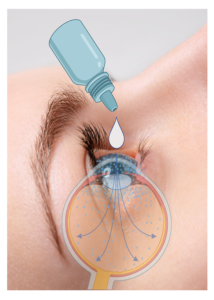
Nanoemulsion eye drop
A team led by Mass Eye and Ear researchers has developed an eye drop to effectively deliver drugs to the retina and other tissues located in the back of the eye, a new technology with potential application for the treatment of multiple blinding diseases. According to a report published online today in Nature Scientific Reports, the new experimental treatment composed of nanoparticles that the researchers called eNano-Ro5, effectively delivers a small molecule inhibitor of the transcription factor RUNX1 to the back of eye in preclinical models. This new technology sets the stage for the development of new modalities of treatment that address multiple conditions that either lack a medical treatment or require administration of approved drugs using eye injections as often as once a month.
The same group of scientists had previously linked excessive function of RUNX1 to the abnormal growth of blood vessels observed in patients with advanced diabetic eye disease (proliferative diabetic retinopathy). They showed that injection of a small molecule inhibitor of RUNX1 into the eye was very effective at curbing aberrant vessel growth in preclinical models, as reported in Diabetes in 2017. For their new study published today in the journal Nature Scientific Reports, the researchers packaged their RUNX1 inhibitor into microscopic nanoparticles, which they administered as eye drops daily to preclinical models of another blinding condition common in individuals with recurrent retinal detachment and severe ocular trauma (proliferative vitreoretinopathy or PVR). eNano-Ro5 delivered effective amounts of the RUNX1 inhibitor to the back of the eye resulting in reduced severity of PVR in preclinical models. PVR currently lacks an approved medical treatment and the only option for patients is to undergo surgical procedures that are often unsuccessful at improving vision.
“When we started working on our eye drop formulation to deliver a RUNX1 inhibitor I saw it as a matter of convenience such that patients would have an alternative to eye injections. But now I see it as a matter of necessity because there is an urgent clinical need for drugs that patients can self-administer under social distancing precautions,” said co-corresponding author Joseph F. Arboleda-Velasquez, MD, PhD, assistant scientist at Schepens Eye Research Institute of Mass Eye and Ear and assistant professor of Ophthalmology at Harvard Medical School.
“It is clear the RUNX1 plays a role in multiple pathological conditions within the eye and beyond. Retinal detachment and PVR has been a vexing problem for retinal surgeons. Developing a topical agent that effectively treats PVR using a relevant in vivo model is a significant step forward in our treatment of this sight-threatening condition,” said co-corresponding author Leo A. Kim, MD, PhD, a retina surgeon at Mass Eye and Ear and assistant professor of Ophthalmology at Harvard Medical School. “We are also grateful that we were able to advance this meaningful work in part through philanthropic support.”





Dirk De Clercq () is surely an Assistant Professor of Entrepreneurship at Brock University.
Vance H. Fried () will be the Brattain Professor of Management at
Oklahoma State University. Oskari Lehtonen () can be a Doctoral
prospect on the Swedish School of Economics and Business Administration,
Helsinki Finland. Harry J. Sapienza () can be a Professor of
Strategic Management and Organization as well as Curtis L.
Carlson Chair of Entrepreneurial Studies within the Carlson School of Management, University of Minnesota.